Image transparency, a fundamental element in design, photography, and content creation, has become increasingly indispensable in today's digital landscape. The ability to seamlessly remove backgrounds and make an image transparent is essential for creating visually striking graphics, enhancing product displays, and adding depth to multimedia projects. Precision and quality in achieving transparency are paramount, and in this blog, you will learn how to make an image transparent effortlessly with a single click, using an online tool. We'll guide you through the process, ensuring that you can harness the power of transparent images to elevate your creative endeavors.
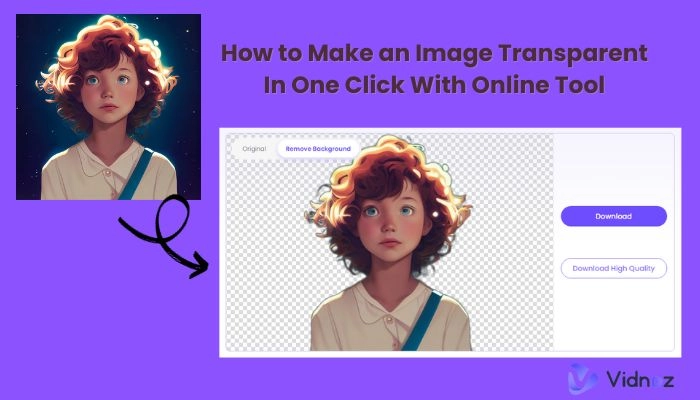
- On This Page
-
Vidnoz AI Background Remover - Image Transparent in One Click
How to Make an Image Transparent With Vidnoz AI Background Remover
-
Adobe Photoshop - Professional Precision for Transparent Images
How to Make an Image Transparent with Adobe Photoshop
-
GIMP - User-Friendly Image Transparency Tool for Beginners
How to Make an Image Transparent With GIMP
-
Adobe Illustrator - Seamless Vector Transparency for Designers
How to Make an Image Transparent with Adobe Illustrator
-
Summary of These Methods for Making a Picture Transparent
-
Common Use Cases of Transparent Images
Vidnoz AI Background Remover - Image Transparent in One Click
Vidnoz AI Background Remover, a powerful online tool that enables users to make an image transparent with AI technology. This innovative solution boasts several noteworthy features, making it an invaluable resource for graphic designers, photographers, and anyone seeking a quick and precise way to remove image backgrounds.
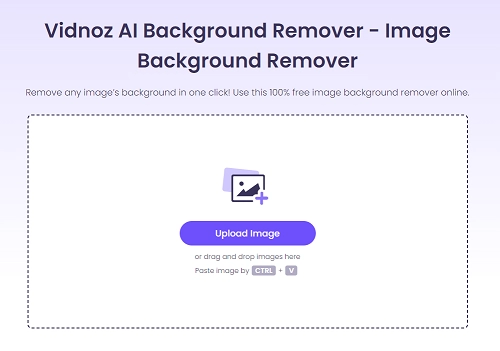
Features:
1. Precision in Background Removal: Vidnoz AI Background Remover employs advanced AI algorithms to accurately isolate the subject from the background, ensuring that other objects, such as people or products, remain unaffected.
2. Time-Saving and User-Friendly Interface: The tool's streamlined interface simplifies the process, allowing users to achieve transparent backgrounds in mere seconds. Its efficiency is particularly advantageous when working with multiple images.
3. High-Definition Image Preservation: After background removal, Vidnoz preserves the original image's high-definition quality without any loss, blur, or compression, making it an ideal choice for professionals who prioritize image excellence.
How to Make an Image Transparent With Vidnoz AI Background Remover
To make an image transparent with Vidnoz AI Background Remover, follow these simple steps:
Step 1. Upload Your Image: Visit Vidnoz website and upload the image you want to edit. The powerful AI algorithm will automatically detect and remove the background, leaving your subject intact.
Step 2. Download Your Transparent Image: Once the process is complete, download your transparent image with its original high-definition quality.

Adobe Photoshop - Professional Precision for Transparent Images
Adobe Photoshop is a powerful tool that offers professional-grade precision when it comes to making images transparent or unblur image. Whether you're a graphic designer or someone seeking high-level control over image transparency, Photoshop's advanced features make it the ideal choice.
How to Make an Image Transparent with Adobe Photoshop
Step 1: Open Your Image: Launch Photoshop and open the image you want to make transparent.
Step 2: Select the Layer: In the Layers panel, select the layer containing your image.
Step 3: Create a Mask: Click the "Add Layer Mask" button at the bottom of the Layers panel. This will add a mask to your image layer.
Step 4: Use the Brush Tool: Select the Brush tool and set its opacity to control the level of transparency you want to achieve.
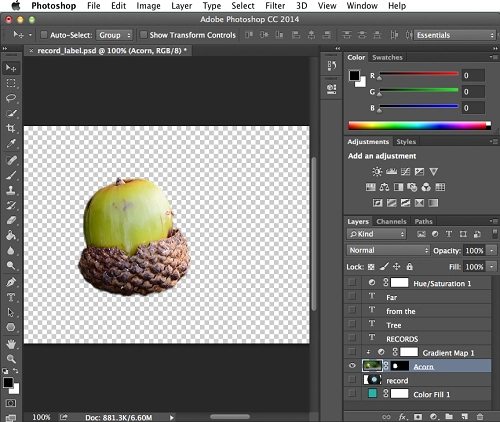
Step 5: Paint on the Mask: Paint over the areas you want to make transparent. You'll see the image becoming transparent in real-time.
Step 6: Refine as Needed: Adjust the brush size, opacity, and hardness to achieve precise results.
Step 7: Save Your Image: Once you're satisfied, save your transparent image in a format like PNG that supports transparency.
Photoshop's ability to work with layers, masks, and precise brush controls ensures that you can achieve the desired level of transparency with ease. It's the go-to choice for professionals and anyone looking to make images transparent with precision and control.
GIMP - User-Friendly Image Transparency Tool for Beginners
GIMP (GNU Image Manipulation Program) is a powerful yet approachable image background remover and editor known for its user-friendly interface. In the context of making images transparent, GIMP offers a versatile and accessible solution for both beginners and experienced users. This article explores how to create transparent images using GIMP.
How to Make an Image Transparent With GIMP
To begin, open GIMP, available on both Windows and Mac. Remember to save your image as a PNG to retain transparency. Here's a step-by-step guide:
Step 1: Open GIMP and load your image.
Step 2: Click "Windows" and select "Dockable Dialogs," then choose "Layers."
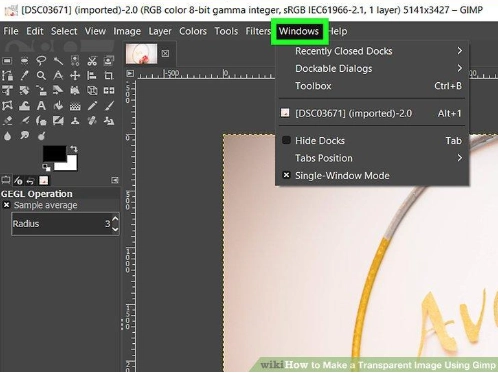
Step 3: In the "Layers" window, select your image.
Step 4: Adjust the image's transparency by lowering the "Opacity" value, monitor the image to achieve your desired transparency level, typically, reducing opacity from 100 to 50 is sufficient.
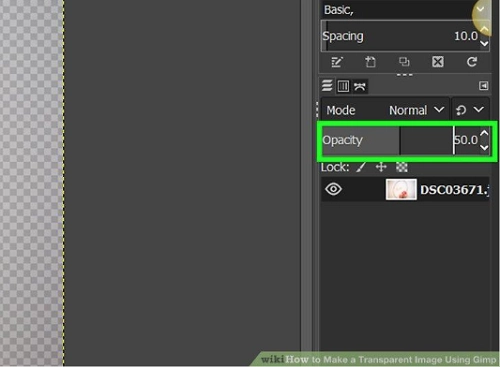
Step 5: Close the "Layers" window.
Step 6: Click "Image" and select "Flatten Image" to preserve transparency.
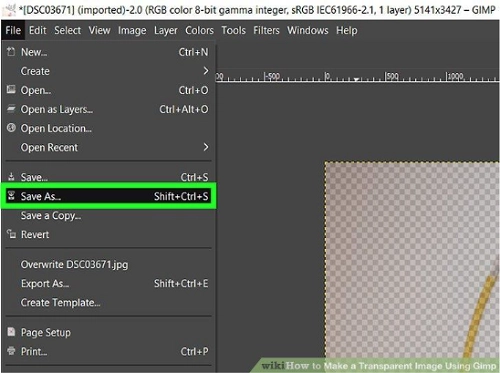
Step 7: Export your project as a PNG file. The default export settings will save your project as a JPG, but you'll need to change this in order to maintain your image's transparent background.
GIMP's intuitive interface and these easy-to-follow steps make it an ideal choice for creating transparent images, whether you're a beginner or an experienced editor.
Adobe Illustrator - Seamless Vector Transparency for Designers
Adobe Illustrator is an image background remover for designers seeking seamless vector transparency in their projects, particularly for logo creation and vector-based illustrations. Its popularity among designers worldwide stems from its user-friendly interface and the ability to effortlessly remove backgrounds, making it an ideal tool for those looking to create transparent images.
Adobe Illustrator stands out due to its advanced features and user-friendly design. Beginners can quickly grasp its functionality, while experienced designers appreciate its scalability and the exceptional quality of results it produces. The in-panel editing feature streamlines multitasking and ensures design consistency across multiple artboards, saving valuable time.
Also read: Top 5 Best AI Image to Video Generators >>
How to Make an Image Transparent with Adobe Illustrator
Step 1: Open Your File in Illustrator: Start by opening your image or logo file using the "File > Open" option.
Step 2: Select the Transparency Grid: Activate the transparency grid by navigating to "View > Show Transparency Grid" to view transparent and white areas clearly.
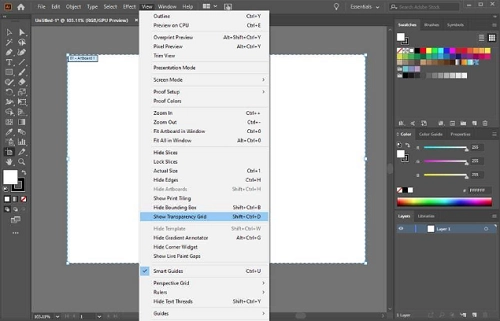
Step 3: Trace Your Image: Open the trace window through "Window > Trace Image" to highlight areas that need transparency.
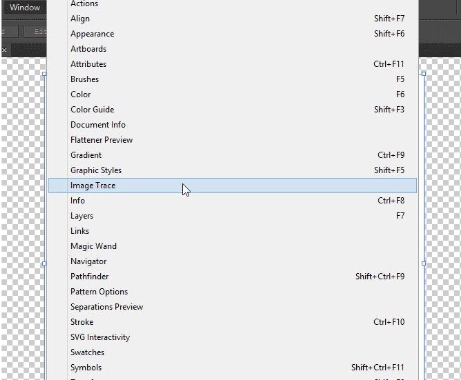
Step 4: Customize Your Tracing Settings: Adjust settings, such as leaving the preset to default or choosing custom options, selecting "Color" in Mode, "Full Tone" in Palette, and setting Method to "Abutting" in the Advanced tab. Enable "Snap Curves to Lines" and "Ignore White" options. Click "Trace."
Step 5: Review & Save Your Image: Review the image's transparency carefully. Save it in PNG format via "File > Save As" and select "File > Select for Web" to save it as a transparent PNG.
By following these steps, you can effortlessly create transparent images with Adobe Illustrator, making it an invaluable tool for designers seeking seamless vector transparency.
Also read: Best AI Cartoon Generators to Make Cartoon Character >>
Summary of These Methods for Making a Picture Transparent
In summary, when it comes to making an image transparent, Vidnoz AI Background Remover stands out as the ultimate choice. This innovative online tool harnesses the power of AI technology to offer unparalleled benefits. Its precision in background removal ensures that subjects are perfectly isolated, making it ideal for graphic designers and photographers.
The user-friendly interface saves valuable time, and its ability to maintain high-definition image quality sets it apart. When compared to alternatives like Adobe Photoshop, GIMP, and Adobe Illustrator, Vidnoz AI Background Remover emerges as the most efficient and effective solution.
Common Use Cases of Transparent Images
Web Design:
Transparent images are indispensable in AI web design. They enable the creation of visually captivating websites by overlaying text or elements on images with varying levels of transparency. This technique adds depth, style, and context to the content, enhancing user engagement and aesthetics.

Logo Design:
Transparent backgrounds facilitate logo design, enabling the incorporation of smooth gradients or drop shadows that seamlessly blend with any backdrop. This versatility ensures logos appear professional and adaptable across various platforms and materials. You can easily create a logo by using a professional text to image generator.
Image Overlays:
Transparent images allow for creative image overlays, such as watermarking or crafting image collages. This can be particularly useful for branding or storytelling, merging multiple visuals effortlessly.
Presentations:
In presentations, transparent images come in handy for adding context without obstructing the content. Incorporating transparent images enhances visual appeal and aids in conveying complex ideas effectively.
Watermarks and Labels:
Transparent images are vital for protecting content. They are used to add semi-transparent watermarks or labels that indicate ownership or copyright information, deterring unauthorized use while allowing the underlying image to remain visible.
Conclusion
In conclusion, thanks to online tools that simplify the procedure, making an image transparent has never been simpler. You may easily eliminate backgrounds and produce beautiful, expert-looking photographs with only one click. These tools are practical and effective for editing images for both personal and professional use. Don't be afraid to put your newfound knowledge to use and start using transparent images in your projects. We strongly advise trying Vidnoz AI Background Remover, an outstanding tool to make your photographs transparent with ease, for those looking for a strong AI-driven solution. Transform your images precisely and easily right now!














![FakeYou Text to Speech Reviews & Best 3 Alternatives [2025]](https://www.vidnoz.com/bimg/fakeyou-text-to-speech-1.webp)
![[Solved] How to Custom AI Voice with 3 Free Online Tools?](https://www.vidnoz.com/bimg/cover-of-custom-ai-voice.webp)

![Best 5 Tools for How to Remove Backgrounds from GIFs - [Detailed Steps Included]](https://www.vidnoz.com/bimg/remove-backgrounds-from-gifs.webp)


